Mars, once a planet abundant with water, now lies as a barren, arid expanse. Its surface features reveal a history where water once flowed freely. Over the last three billion years, some of that water has migrated deep underground. But the fate of the remaining water has long baffled scientists.
Recent findings, aided by NASA’s Hubble Space Telescope and the Mars Atmosphere and Volatile Evolution (MAVEN) mission, are shedding light on this enigma. These missions have brought researchers closer to understanding how Mars transitioned from a wet world to the dry landscape we see today.
John Clarke, a scientist at Boston University’s Center for Space Physics, is at the forefront of this investigation. According to Clarke, Mars’ water had two possible fates: freezing into the ground or breaking into molecular components, with the resulting hydrogen and oxygen atoms escaping into space.
“To understand how much water there was and what happened to it, we need to study how the atoms escape into space,” Clarke explains.

Clarke’s team uses data from Hubble and MAVEN to monitor the current rate of hydrogen atom escape from Mars’ atmosphere. By analyzing these rates, they can trace back the timeline of water loss, constructing a detailed narrative of the planet’s transformation from its wet, warm past to its current desolate state.
On Mars, sunlight breaks apart water molecules in the atmosphere into hydrogen and oxygen atoms. This process, known as photodissociation, releases two types of hydrogen: regular hydrogen and a heavier isotope called deuterium. Deuterium contains a neutron in its nucleus, giving it twice the mass of normal hydrogen. Due to this increased mass, deuterium escapes Mars’ atmosphere more slowly than hydrogen.
Related Stories
Over time, more hydrogen escapes than deuterium, leading to a higher ratio of deuterium to hydrogen in the atmosphere. Measuring this ratio allows scientists to estimate how much water was once present on the Red Planet. By studying the current escape rates of these atoms, they can also learn about the processes that have influenced water loss over the last four billion years.
While the MAVEN spacecraft provides most of the data used in this research, it isn’t sensitive enough to detect deuterium throughout the entire Martian year. Mars follows an elliptical orbit around the Sun, which means it swings far from the Sun during its long winter.
As a result, deuterium emissions become too faint for MAVEN to measure during this period. To fill in the gaps, Clarke’s team turned to Hubble, which has been observing Mars since 1991, well before MAVEN’s 2014 arrival. By combining data from both missions, they were able to construct a complete annual cycle of hydrogen and deuterium escape rates for three Martian years, each equivalent to 687 Earth days.
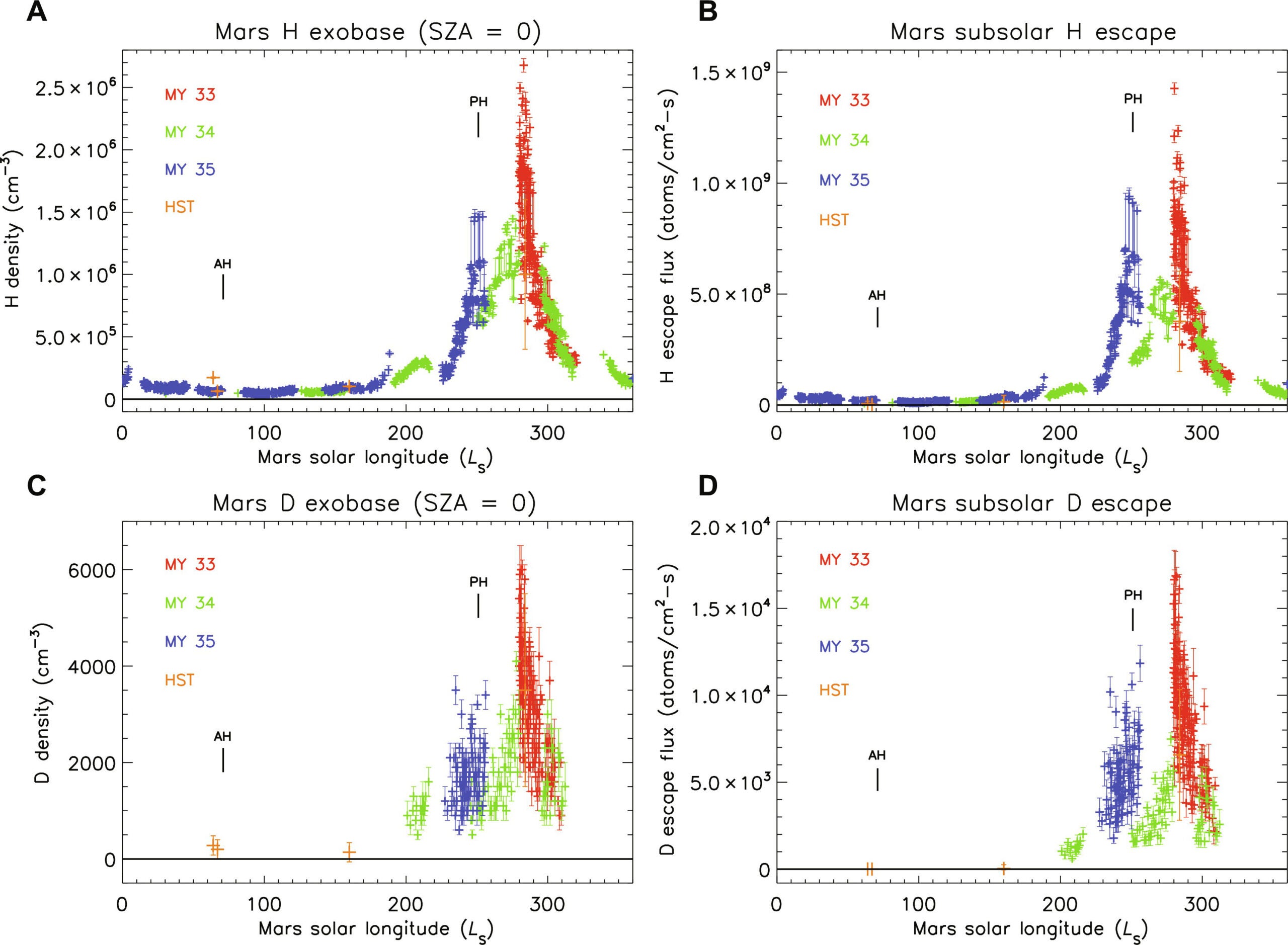
This collaboration between Hubble and MAVEN gave scientists the first comprehensive view of hydrogen atoms escaping into space from Mars. These findings help explain what happened to Mars’ water and provide clues about the planet’s ancient climate.
Mars’ atmosphere is far more dynamic than previously thought. Clarke notes, “In recent years, scientists have found that Mars has an annual cycle that is much more dynamic than people expected 10 or 15 years ago.” The atmosphere heats up and cools down rapidly, sometimes in just a matter of hours. This turbulence is influenced by Mars’ distance from the Sun, which varies by up to 40% over the course of a Martian year.
This new understanding of Mars’ atmosphere has led to two major discoveries. First, when the planet is closer to the Sun, water molecules rise through the atmosphere much more rapidly than expected, releasing hydrogen and deuterium at high altitudes. Second, the rapid fluctuations in hydrogen and deuterium escape rates suggest that these atoms need additional energy to escape Mars’ gravity.
At normal atmospheric temperatures, only a small fraction of atoms has enough energy to escape. But when Mars is close to the Sun, the water molecules in its atmosphere absorb energy, which allows more atoms to escape into space.
In addition, solar wind protons and sunlight-driven chemical reactions provide extra energy, causing more atoms to break free from Mars’ atmosphere. This explains why the escape rates of hydrogen and deuterium vary so much throughout the Martian year.
The study of Mars’ water history is critical for understanding not only the Red Planet but also other Earth-sized planets in distant star systems. Astronomers have discovered many such planets, but their distance from Earth makes them difficult to study in detail.
Mars, along with Earth and Venus, resides in or near the “habitable zone” of our solar system, where liquid water could exist. However, each of these planets has evolved under vastly different conditions, providing scientists with natural laboratories for studying how planets in habitable zones can change over time.
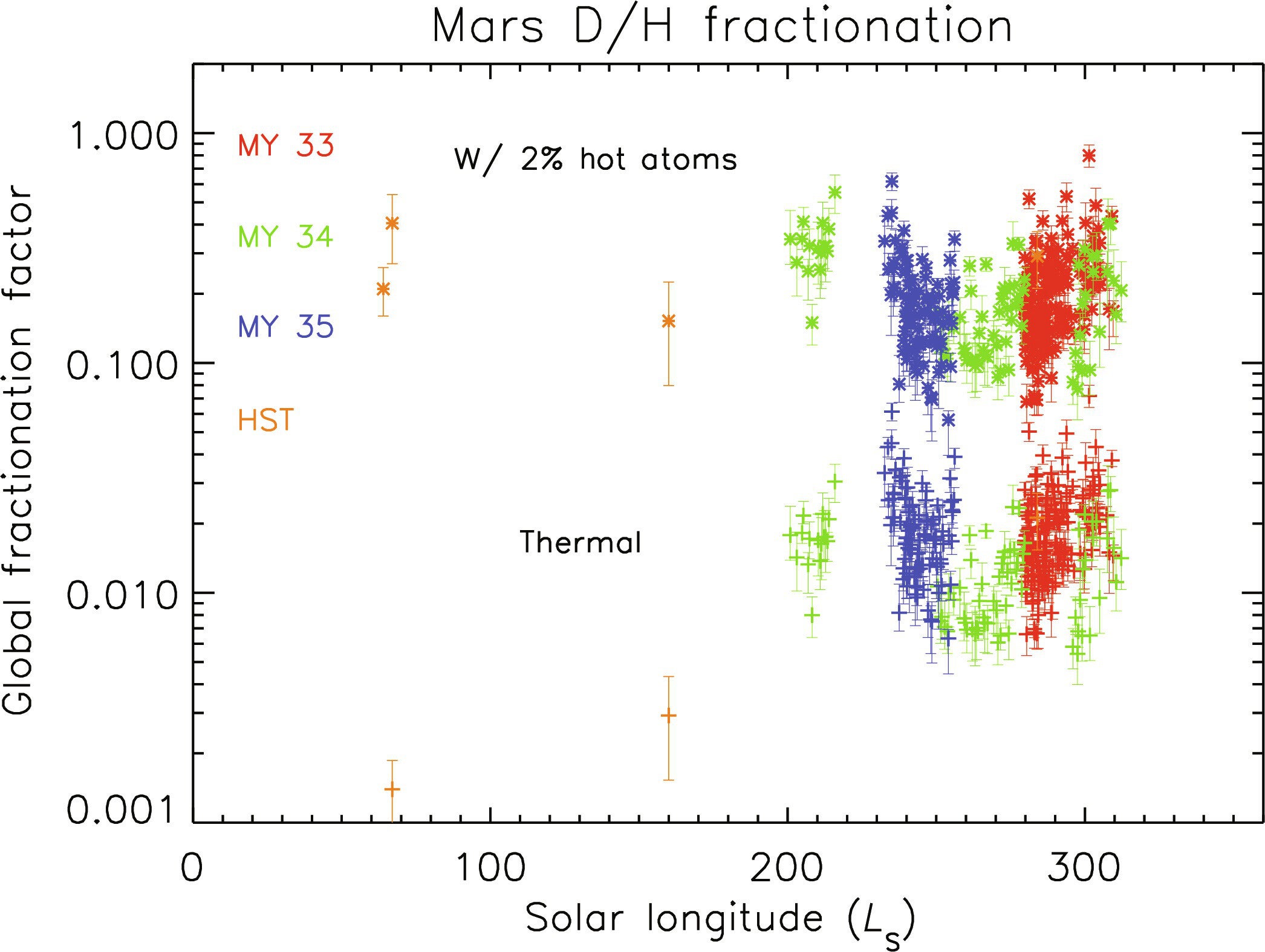
By examining Mars’ past, scientists hope to gain insights into the conditions that allow liquid water, and potentially life, to exist on distant planets. Clarke’s work, along with the data from Hubble and MAVEN, is helping to piece together the puzzle of water loss on Mars, a crucial step toward understanding the history of water in our solar system and beyond.
These findings were published in Science Advances, a journal by the American Association for the Advancement of Science.
The MAVEN mission (Mars Atmosphere and Volatile EvolutioN), launched by NASA in 2013, was designed to study the upper atmosphere of Mars. Its primary goals were to understand how Mars lost its atmosphere over time and to investigate the history of Martian climate change.
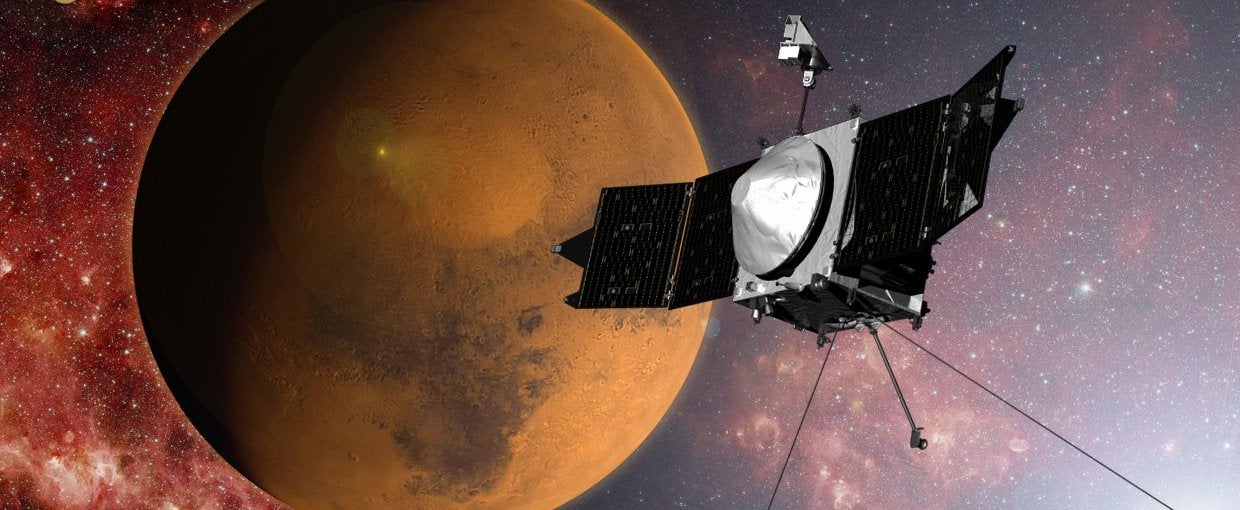
Scientists aimed to learn more about why Mars, which likely had a thicker atmosphere and liquid water in the past, became the cold and arid planet it is today.
Understand atmospheric loss: MAVEN aimed to determine how much of Mars’ atmosphere has been lost to space over time, focusing particularly on the role of the solar wind and solar storms.
Study the current state of the Martian atmosphere: The mission sought to understand how the remaining atmosphere behaves today, including how it interacts with solar winds and radiation.
Investigate ancient water loss: Scientists wanted to determine how the loss of atmospheric gases like hydrogen and oxygen contributed to the disappearance of liquid water from the Martian surface.
Extreme atmospheric erosion: One of MAVEN’s first big results was discovering that the erosion of Mars’ atmosphere increases significantly during solar storms. The team studied how the solar wind — a stream of charged particles continually streaming from the Sun — and solar storms continually strip away Mars’ atmosphere, and how this process played a key role in altering the Martian climate from a potentially habitable planet to today’s cold, arid planet.
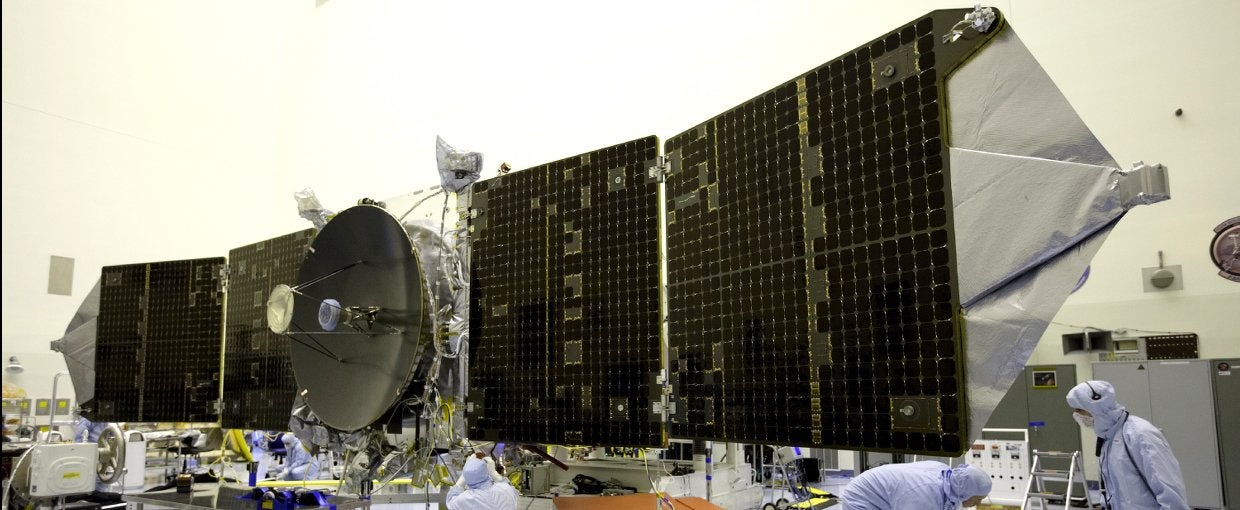
Sputtering to space: To better understand how Mars lost much of its atmosphere, MAVEN measured isotopes of argon gas in the upper Martian atmosphere. Argon is a noble gas, meaning it rarely reacts with other constituents in the Martian atmosphere. The only way it can be removed is by atmospheric sputtering — a process where ions crash into the Martian atmosphere at high enough speeds that they knock gas molecules out of the atmosphere. When the MAVEN team analyzed argon isotopes in the upper atmosphere, they were able to estimate that roughly 65% of the argon originally present had been lost through sputtering over the planet’s history.
A new type of aurora: MAVEN has discovered several types of auroras that flare up when energetic particles plunge into the atmosphere, bombarding gases and making them glow. The MAVEN team showed that protons, rather than electrons, create auroras at Mars. On Earth, proton auroras only occur in very small regions near the poles, whereas at Mars they can happen everywhere.
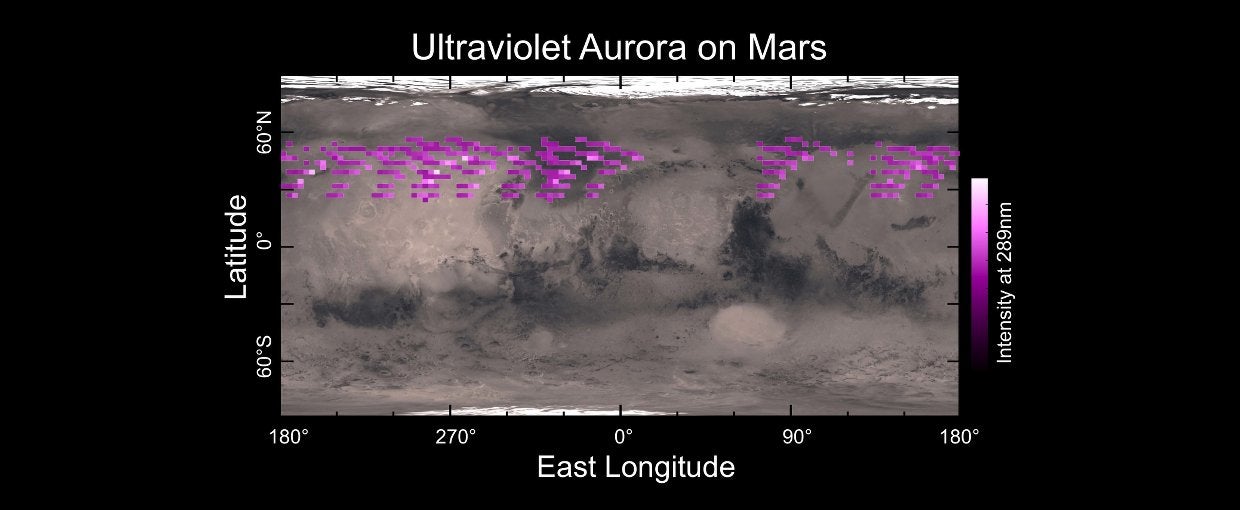
Martian dust storm: In 2018, a runaway series of dust storms created a dust cloud so large that it enveloped the planet. The MAVEN team studied how this “global” dust storm affected Mars’ upper atmosphere to understand how these events affect how the escape of water to space. It confirmed that heating from dust storms can loft water molecules far higher into the atmosphere than usual, leading to a sudden surge in water lost to space.
Map of Martian winds: MAVEN researchers created the first map of wind circulation in the upper atmosphere of Mars. The new map is helping scientists better understand the Martian climate, including how terrain on the planet’s surface is disturbing high-altitude wind currents. The results provide insight into how the dynamics of the upper Martian atmosphere have influenced the Red Planet’s climate evolution in the past and present.
Twisted tail: Mars has an invisible magnetic “tail” that is twisted by its interaction with the solar wind. Although models predicted that magnetic reconnection causes Mars’ magnetotail to twist, it wasn’t until MAVEN arrived that scientists could confirm that the predictions were correct. The process that creates the twisted tail could also allow some of Mars’ already thin atmosphere to escape to space.
Mapping electric currents: Researchers used MAVEN data to create a map of electric current systems in the Martian atmosphere. These form when solar wind ions and electrons smash into the planet’s induced magnetic field, causing the particles to flow apart. The resulting electric currents, which drape around the planet, play a fundamental role in the atmospheric loss that transformed Mars from a world that could have supported life to an inhospitable desert.
Disappearing solar wind: MAVEN recently observed the unexpected “disappearance” of the solar wind. This was caused by a type of solar event so powerful that it created a void in its wake as it traveled across the solar system. MAVEN’s measurements showed that when it reached Mars, the solar wind density dropped significantly. This disappearance of the solar wind allowed the Martian atmosphere and magnetosphere to balloon out by thousands of kilometers.
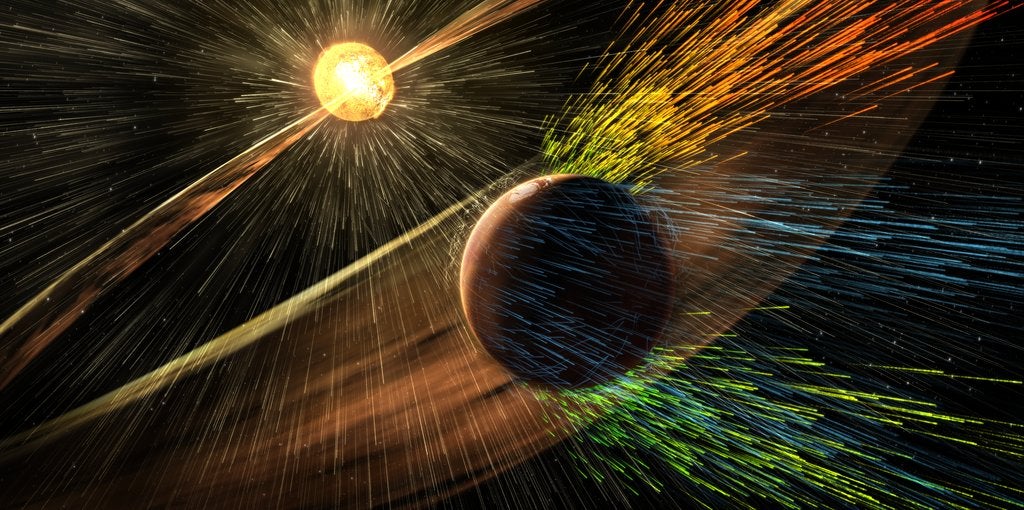
Ultraviolet views of the Red Planet: MAVEN captured stunning views of Mars in two ultraviolet images taken at different points along the Red Planet’s orbit around the Sun. By viewing the planet in ultraviolet wavelengths, scientists gain insight into the Martian atmosphere and view surface features in remarkable ways.
Mars’ response to solar storms: In May 2024, a series of solar events triggered a torrent of energetic particles that quickly traveled to Mars. Many of NASA’s Mars missions, including MAVEN, observed this celestial event and captured images of glowing auroras over the planet.
MAVEN continues to provide valuable data that helps scientists unravel Mars’ past and better understand its atmospheric processes today. These findings also aid future missions in exploring the potential for human habitation on the planet.
Note: Materials provided above by The Brighter Side of News. Content may be edited for style and length.
Like these kind of feel good stories? Get The Brighter Side of News’ newsletter.
The post NASA scientists reveal what happened to the water on Mars appeared first on The Brighter Side of News.